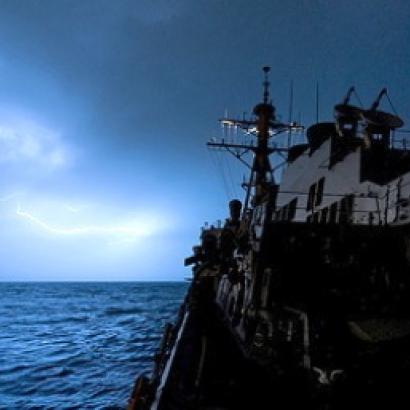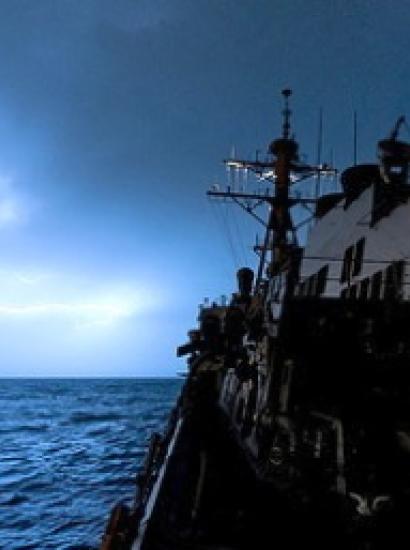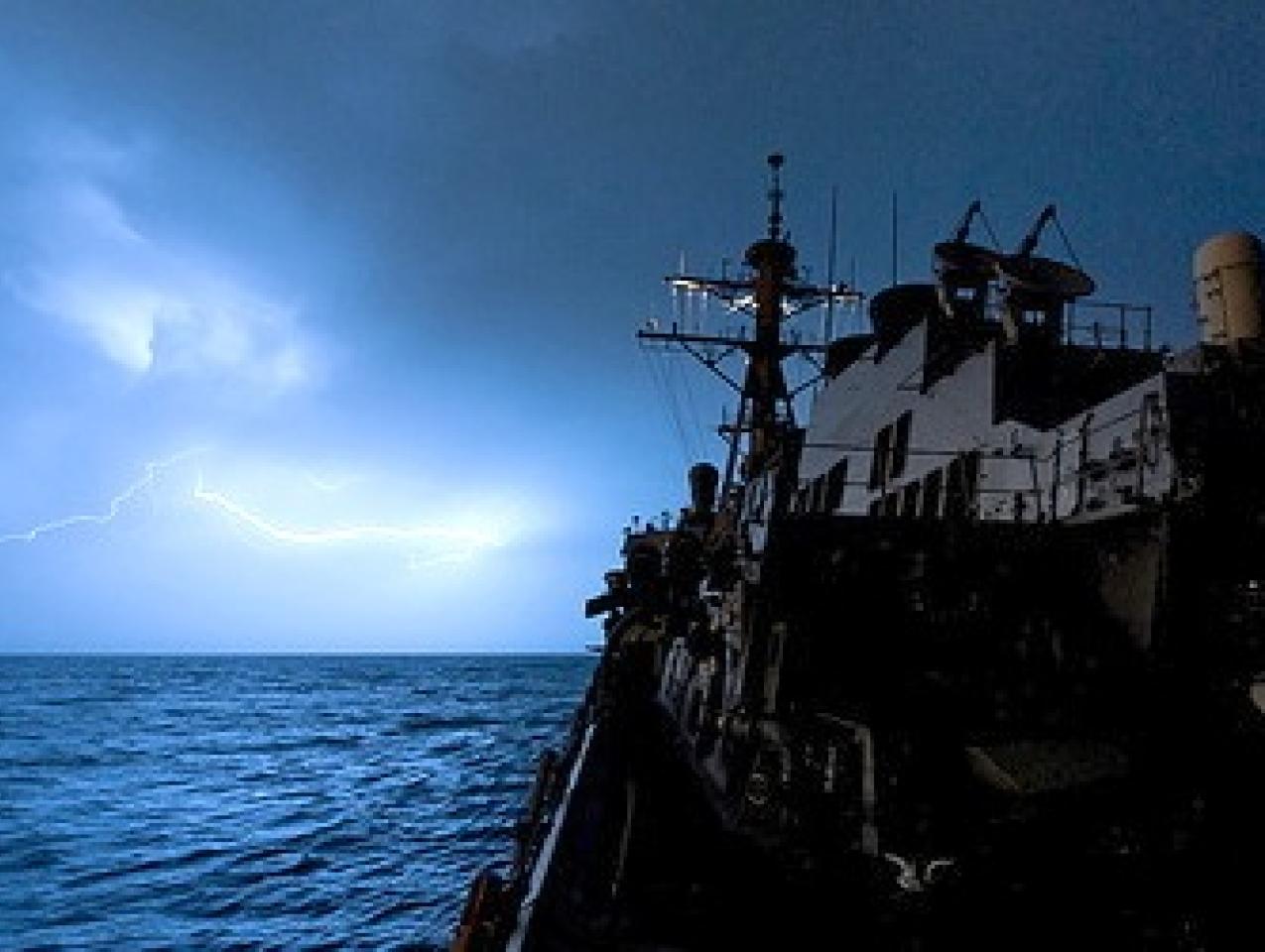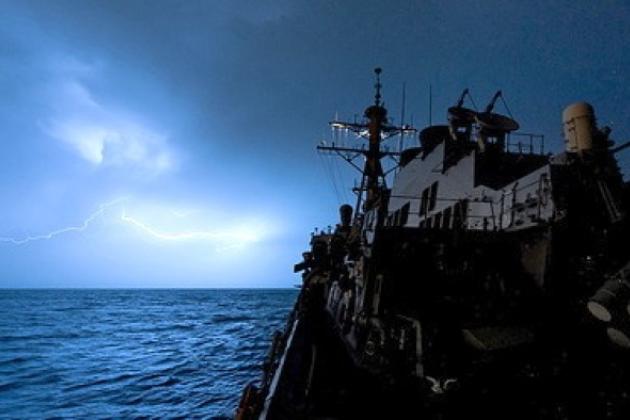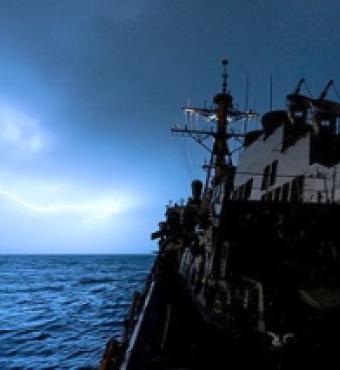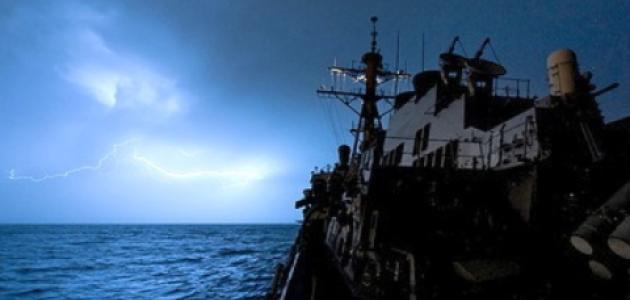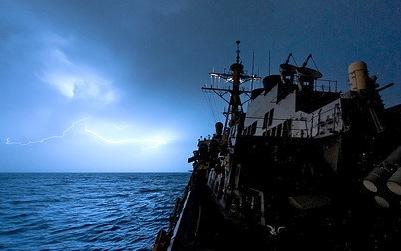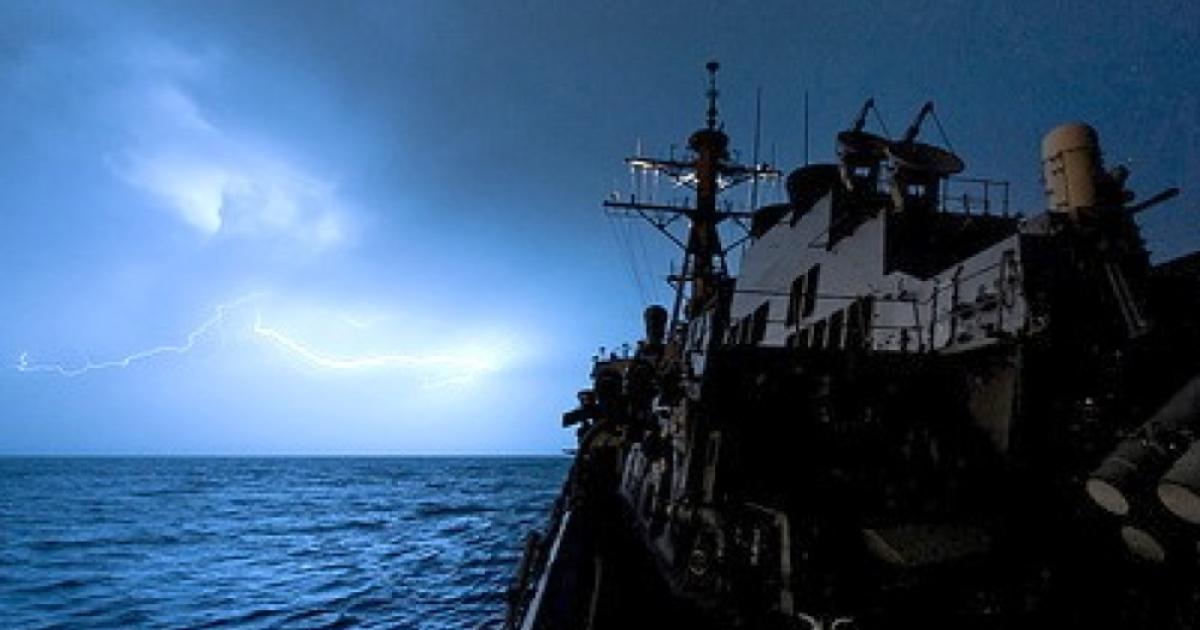Editor's note: The following essay is an excerpt from the Hoover Press book, Jihad in the Arabian Sea.
The Bab el-Mandeb, the strait that separates the Red Sea from the Indian Ocean, has conjoined Africa and Asia for centuries. It likely was the first route taken by Homo sapiens on their journey out of Africa, and the traffic between the Horn and Arabia has continued apace to this day. Men, goods, and ideas have gone back and forth, giving the Arabian Sea a degree of integration and similarity that is obfuscated by the arbitrary taxonomy of modern geography: Africa vs. Asia; the Horn of Africa vs. Arabia vs. South Asia. Only some 3,300 kilometers (about 1,800 nautical miles) separate Mumbai from Djibouti, the extreme range of a series of seaports and islands that dot the Arabian Sea: Massawa, Djibouti, Aden, Berbera, Mogadishu, Socotra, Muscat, Hormuz, Gwadar, Karachi, Mumbai.
The harsh, unforgiving environment is another factor of uniformity, as is the seasonal rhythm of the monsoon winds, which influences cattle migrations, harvests and, back in the era of sailboats, the coming and going of merchants. And there is khat, a shrub grown on the plateaus of Ethiopia and Yemen whose leaves are chewed ubiquitously by the locals for its euphoric properties and for suppressing appetite in times of famine. Given its central location in the Eurasian trade route for at least the past 2,500 years, the region has been continuously exposed to the flux of historical change, to new ideas and technologies passing through. Yet, the ancient states that once existed—the Sabean kingdom, Aksum—passed and were not replaced. Major civilizations are born on the beds of large rivers, but the lands that skirt the Gulf of Aden and the Arabian Sea have run dry, an arid belt stretching from the Nile to the Indus.
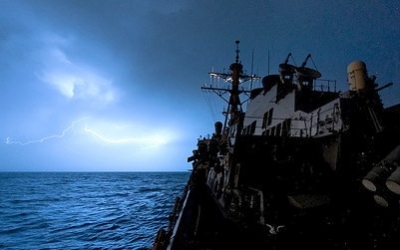
Photo credit: An honorable German (via flickr)
The environment has continuously degraded over the millennia, partly as a result of local climate change, partly due to human activity. The wooded hills have given way to rocky crags, the meadows turned into dust bowls. Both shores of the Bab el-Mandeb are among the hottest places on earth. Water is mostly found in the aquifer that is slowly being depleted; the rivers of the rainy season do not reach the sea. For most of the past 1,000 years, the lack of natural resources has allowed only light population density, minimal capitalization, and sporadic political centralization. Nomadic tribalism and sparse settlements have been a dominant form of social organization, with the occasional rise of a monarchic dynasty that never quite had it to evolve into more permanent forms of statehood.
These constraints were never lifted in the postcolonial era. Britain, France, and Italy ruled over the region lethargically and departed between the 1940s and the 1970s, leaving nominally independent states that proved to be of limited sustainability. Djibouti came to live off strategic rent paid by the United States and France. Somalia failed as a state in 1991, and has since eluded attempts to form a centralized polity. Yemen has been in a marginally better situation, using limited oil reserves to maintain a degree of political cohesion, which after thirty years of one-man rule has been worn down by both political and economic forces.
At the dawn of the twenty-first century, the challenges for the countries on the littoral of the Arabian Sea are civil war(s), piracy, radical Islamism, transnational terrorism, and a real risk of environmental and economic failure on both sides of the strait. Yet, its strategic importance as a conduit for maritime trade between Asia and the Mediterranean world is as great as it was when Egyptian pharaohs built a canal between the Nile and the Red Sea. Then, just as today, the lands around the Bab el-Mandeb were as difficult to pacify as the Red Sea was treacherous to navigate. The historical documents found in the Cairo Geniza show that in tenth-century A.D., vessels leaving Egypt sailed in a convoy along the route to India in order to deter a profusion of local pirates.
Islam came early to the region, during the life of the Prophet Muhammad, carried by small groups of refugees when the young Muslim community was still persecuted in Mecca. In the following centuries, Islam settled throughout the Indian Ocean amid the numerous merchant communities that thrived under the aegis of Pax Islamica.
Civil wars, piracy, radical Islamism, transnational terrorism, and a real risk of environmental and economic failure plague this region.
Arab Muslim traders would dominate that commerce for a thousand years, their dhows sailing from the mouth of the Red Sea down the African coast to Malindi, in Kenya; across the Arabian Sea to Mumbai and Goa, in India; through the Strait of Malacca all the way to Canton, in South China. Their activities were regulated by the commercial law of the Sunni Shafi’i school of jurisprudence, which as a result became dominant in the Indian Ocean. Sufi orders expanded to form long-distance networks, providing travelers with trusted local agents and housing facilities. Zheng He, the legendary Chinese navigator of the fifteenth-century, was a Muslim.
Muslim dominance of the maritime commerce in the Indian Ocean continued until the seventeenth century. Following Vasco da Gama’s first trip to India, in 1498, the Portuguese had forced themselves onto that ecosystem but without changing much of its fundamental characteristics. The Portuguese were pirates and petty traders in a world of pirates and petty traders. Western supremacy came later, with the Dutch and the British trading companies. Commercial dominance led to political dominance, and the 1757 Battle of Plassey delivered Bengal to Robert Clive of the East India Company.
Muslim power was waning throughout the Indian Ocean. The Mughal Empire, the world’s richest Muslim polity of the early modern period, a torchbearer for Islam’s secular power, was losing ground in the Indian peninsula to British interests. Soon it was the turn of the Muslim sultanates of the Southeast Asian archipelago (in today’s Indonesia and Malaysia) to pass under the protection of the Dutch and the British companies. The littoral sultanates of the Arabian Peninsula (modern-day Yemen, Qatar, Bahrain, Kuwait, and the United Arab Emirates) would make similar arrangements with Britain in the early nineteenth century. The coast of Muslim Africa was next.
The African continent produced ardent defenders of Muslim sovereignty against European imperial expansion. In 1830, a French expeditionary corps was sent on a whim to invade Algiers. And there stood Abd al-Kadir, the Algerian Sufi shaykh who held the lines against the French Army—not so long before, Napoleon’s Great Army—for seventeen years. The French would have to commit a vast contingent and ravage the country to get him to surrender. They would go on in their African ventures to build a canal between Suez on the Red Sea and Port Said on the Mediterranean, which in a roundabout way delivered Egypt and Sudan to the British.
And there stood Muhammad Ahmad, the Sudanese shaykh of the Samaniyah Sufi order and self-proclaimed Mahdi (“messiah”) who, in 1881, rose in rebellion against Anglo-Egyptian rule. Muhammad Ahmad’s followers—the Ansars—famously massacred a British contingent led by Maj. Gen. Charles Gordon at the 1885 Battle of Khartoum, setting back the British claim over Sudan for thirteen more years. While Abd al-Kadir was religiously moderate—and would spend the rest of his days authoring poetry and religious exegesis—Muhammad Ahmad’s call was already fundamentalist. The ferocity and determination of the Mahdi’s Ansars, attributed to their religious fanaticism, would become the stuff of British colonial lore.
In time, many Muslims adopted nostalgic, reactionary attitudes that prevented them from formulating a coherent response to the changes of the modern world.
Abd al-Kadir and Mahdi Muhammad Ahmad were both Sufi shaykhs. Sufism is a syncretistic form of Islam, which reconciles a classical, monotheist Sunni theology with mystical, folkish practices, in particular the veneration of holy men. The Samaniyah order of Mahdi Muhammad Ahmad combined its Sufi orientation with elements of militant fundamentalism emerging in Arabia and south Asia from the mid-eighteenth-century.
This fundamentalist surge, propelled by global modernizing forces and Western encroachment in Muslim lands, has given the world new terms, or new meanings to old terms. Salafism refers to the legal doctrine that underpins the fundamentalist revival. Its principle is to eschew centuries of Islamic jurisprudence and refer back to the fundaments, the texts and records of the time of the Prophet. In practice, salafism proposed to withdraw legislative and judiciary authority from the Muslim empires and transfer them to a scholarly elite qualified to issue legal decisions: the mujtahids, the scholars who issue fatwas. The salafi preachers had a political agenda: in the name of tradition, they were proposing a politico-legal revolution.
Wahhabism, named after the Arabian scholar Muhammad ibn abd al-Wahhab, is the variance of salafism that emerged in Najd, a particularly arid region in the center of the Arabian Peninsula. Wahhabism was carried on the battlefields by several generations of the family of al-Saud, a local chieftain. In the early twentieth-century, a scion of the Najdi clan finally implanted the faith at the core of a state-building project, in a kingdom that would bear his name. The proximity of Arabia brought the fundamentalist strain to Yemen, where it is already apparent in the career of Muhammad al-Shawkani.
Al-Shawkani, a scholar who lived from 1760 to 1834, was a full generation younger than abd al-Wahhab (1703–1792). A revered cleric who would rise to be the highest religious authority in the Zaydi (Shia) imamate of north Yemen, al-Shawkani enlisted the salafi method, despite its roots in Sunnism, in support of the local dynasty, the al-Qasimi. A prolific writer, the author of Quranic exegesis and many legal decisions, he exemplifies the intellectual and legal rejuvenation salafism represented in those years.
Yet, neither salafism (reviving Islam) nor modernism (copying the West) could save the great Muslim empires, maladapted to the changing times. Following the ill-fated “Indian Mutiny” of 1857, the Moghul realm became the British Raj. In the crucial decades that followed, the Hindus and Muslims of India took different journeys to modernity, and the Muslims fell behind. For the large Hindu majority, politically subjected but numerically dominant, the British Raj was the opportunity to make new claims to power in the name of Western-like nationalism and of a democracy based on numbers.
For the Muslims, for centuries a ruling minority in the realm, there was nowhere to go but down and many adopted nostalgic, reactionary attitudes that prevented them from formulating a coherent response to the changing circumstances. In 1947, the subcontinent was partitioned, leaving two regions in Punjab and Bengal for Muslims to live in an insular Muslim state that had no historical precedent. The new state of Pakistan would struggle for decades after that to define the kind of society it was—giving the salafis a shot at defining those terms and Islamizing the state.
For the Muslims, a ruling minority in the realm, there was nowhere to go but down.
The Ottoman Empire, once the main power in Europe and the seat of the Muslim caliphate, was by the 1920s reduced to an Anatolian runt, fiercely Turkish and secular. And so, in the latter half of the twentieth century, through decades of heartbreak and soul-searching, salafism crystallized as a retrogressive, proselytizing undercurrent based on modern imaginings of religious and political practices as they may have existed in seventh-century Arabia. Da’awa is the form of proselytism by which salafism is diffused, a grassroots program centered on social work and on teaching the proper rituals for an Islamic life.
In the turbulent 1960s, salafism fused with distinctly modern, revolutionary doctrines of armed struggle. Nationalism, nihilism, Marxism-Leninism, even anarchism were cleansed of their atheist core and recycled into a modern call to jihad. Jihadism became “global” when it adopted, in the 1990s, a transnational strategic orientation, a determination to bring armed struggle to the heart of Western nations.
Salafism, and Wahhabism in particular, vigorously rejected Sufism as a form of idolatry. But in Africa, fundamentalism and Sufism managed to coexist: in Sudan, in Somalia, and also in central Libya, which in the mid-nineteenth-century passed under the influence of the austere Sanussiyya Sufi order. Then, just as today, fundamentalism was an instrument of political mobilization that transcended tribalism and the multitude of interpersonal bonds between local shaykhs (religious and tribal leaders) and their local clients.
Sufism, on the other hand, bound an army of followers to a charismatic leader with supernatural powers, a man granted divine blessing to bring about radical and miraculous social change. Fundamentalism gave feelings of righteousness; Sufism of chosenness. The flirtation of the two, while doctrinally paradoxical, was in Africa a powerful force that could be harnessed for political and military purposes.
There had always been violence in the encounter between Islam and Western powers. Charles Gordon was decapitated at the Battle of Khartoum, and his head presented to his enemy, Mahdi Muhammad Ahmad. Conversely, Gen. Herbert Kitchener, the British victor of the 1898 Battle of Omdurman, which sealed the defeat of the Mahdist state, ordered his men to dispatch wounded Muslim soldiers. Abd al-Kadir, the great hero of the Algerian resistance who was defeated in 1847 and eventually exiled in Damascus, earned international acclaim for protecting Christians in that city during a bout of sectarian violence in 1860. He and his sons walked through the Christian Quarter and invited hundreds to his home, where he promised safety from the mob of Druzes and Kurds. Those were contrasted times when the vicious and the humane, the petty and the magnanimous walked hand in hand.
Zoom forward one century, and the jihad waged by Al Qaeda is grotesquely and irredeemably violent in order to serve a theatrical objective: Al Qaeda has no military power, so it can only strike imaginations. But its gory lethality has had some effect on the ground by redefining the norms of acceptable behavior in the pursuit of political objectives. In the same way that the totalitarianism of the twentieth-century legitimized genocidal policies in the pursuit of an ideal society, jihadism has enabled strains of anti-imperialist sentiments in the Muslim world to discard strategic considerations and indulge in gory, apocalyptic carnivals. The trivialization of atrocity has enabled another type of jihadism, one focused internally on the imposition of order through political terror disguised as Islamic tradition and justice. It is the Islam of the veils, the amputations, and the stonings—it is the spirit of the French Revolution under Robespierre, the reign of the guillotine used to force together a society traumatized by revolutions, wars, and deep social change.
In the turbulent 1960s, salafism fused with distinctly modern, revolutionary doctrines of armed struggle.
Yemen shows symptoms of the first kind of jihadism, Somalia the latter. But as Djibouti and Eritrea show, the main challenge for regional states is not ideology but the economic, environmental, and demographic crises in gestation that could lead to more social dislocation and conflict. In the 1960s and 1970s, current and aspiring regimes across the Bab el-Mandeb flirted with Marxism. But ideological convictions were only skin-deep: Marxism was a tool to handle a society in transition that the rulers did not know how to wield. Human and economic development lagged, and the doctrinal colors eventually dissipated.
From that original failure, things went in different directions. The powers-that-be retained the autocratic logic of Marxism-Leninism, and they used it to build a rent-based authoritarianism. They used the oil rent when they could, but often had to play a dangerous game exploiting their own potential for disorder in order to extract military and economic aid from foreign powers—the strategic rent on which they have become so dependent. There was a saying about Somalia in the 1990s that there is no business like aid business. The pattern has held.
Meanwhile, the discontents draped the revolutionary logic of Marxism-Leninism in the green of the Islamic tradition and made a bid for political control. Control is a good thing. Law and order are necessary for economic activity, but it depends on what kind of law and what kind of order. Both autocracies and fundamentalism are obsessively political, and they lack the disciplined developmental project that the fragile countries and vulnerable populations of the Arabian Sea need. For Yemen to grow Khat, and for Somalia to specialize in livestock, is an invitation to disaster in the drought-prone region. Herds were wiped out when rain failed in 2011, and people began to starve. The famine would have mostly killed in the Shabab-controlled areas of southern Somalia that aid could not reach. But all the countries of the region were affected by the drought, and their governments exposed for their ineptitude and continued dependence on foreign aid.
For foreign powers, the Horn of Africa is a conundrum. The geostrategic risk is mitigated by the logistical limitations of the local outfits, their lack of capacity to project power outside the region. The costs of trying to impose law and order most certainly outweigh the benefits, at least in financial terms. As long as local violence does not make too much of a splash in the global media, foreign governments can look the other way. Even the ransoms paid to the Somali pirates are not as costly as the upkeep of a large, multinational fleet patrolling a vast swath of the Indian Ocean. The pirates really had to push the envelope in 2008–2009 to provoke a reaction from the international community.
Those whose only vocation has been to push the envelope are the different avatars of Al Qaeda: the original Al Qaeda of the African Embassies and the USS Cole, and the new Al Qaeda of the internet and of the weird stratagems. Those are small clusters of individuals incapable of operating on the scale of an insurgency, but who have a narrow and obsessive focus on throwing down the gauntlet to the United States. The strength of Al Qaeda is not its political claims, its bungled strategic rationale, or its unachievable objectives. Its power rides exclusively on the Al Qaeda brand, forged in the conflagration of 9/11 and universally recognized.
Years later, the brand remains a political liability for Western governments. In the world of the twenty-first century, the world of the United Nations, and the world of collective security, mere whiffs of Al Qaeda are a challenge to the fundamental legitimacy of the international state system. It is to keep alive the power of the brand that a handful of jihadists, sheltered in the chaotic region of the Bab el-Mandeb, have remained single-mindedly devoted to killing in the United States and Europe. They are the custodians of the Arabian Sea, the resting place of master global jihadist Osama bin Laden.
The contrast in regional aspirations could not be more striking. While Djibouti is dreaming of becoming a new Dubai, Somaliland is in search of international recognition, Somalia is ransacked by violent fundamentalism, Eritrea is pursuing its rivalry against Ethiopia to the brink of collapse, and Yemen is teetering on the edge of disaggregation. Militant Islamism has variously affected those Muslim countries, with the cases of Djibouti and Eritrea showing that strong police states are barren soil in which jihadism cannot grow. Djibouti is remarkable because, although it fits in the broader regional pattern—ethnic tension, a recent history of civil war, dependency on military aid, a strongman regime—it also shows that even in that wretched part of the world, a country can plan a path for development beyond the exploitation of strategic rent—with the caveat that the Dubai kind of dream is a flirtation with financial disaster.
The Arabia Felix of the Romans is no more: in its stead are failed, sad lands from which native populations scramble to emigrate. Djibouti’s dreams are pinned on a bridge across the Gates of Tears, but on both shores lie poverty, theft, and violence.








